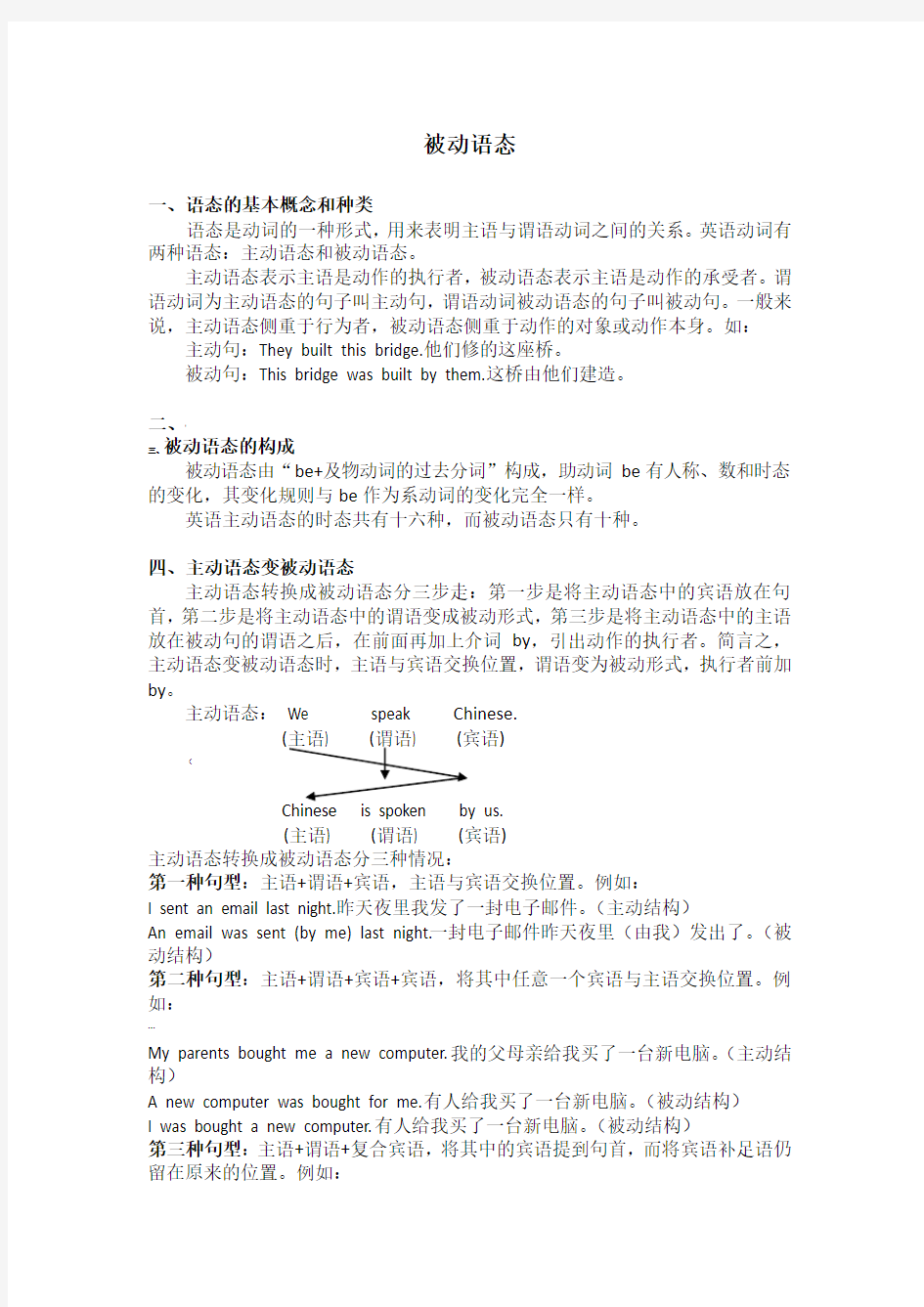高中英语语法被动语态


被动语态
一、语态的基本概念和种类
语态是动词的一种形式,用来表明主语与谓语动词之间的关系。英语动词有两种语态:主动语态和被动语态。
主动语态表示主语是动作的执行者,被动语态表示主语是动作的承受者。谓语动词为主动语态的句子叫主动句,谓语动词被动语态的句子叫被动句。一般来说,主动语态侧重于行为者,被动语态侧重于动作的对象或动作本身。如:主动句:They built this bridge.他们修的这座桥。
被动句:This bridge was built by them.这桥由他们建造。
二、'
三、被动语态的构成
被动语态由“be+及物动词的过去分词”构成,助动词be有人称、数和时态的变化,其变化规则与be作为系动词的变化完全一样。
英语主动语态的时态共有十六种,而被动语态只有十种。
四、主动语态变被动语态
主动语态转换成被动语态分三步走:第一步是将主动语态中的宾语放在句首,第二步是将主动语态中的谓语变成被动形式,第三步是将主动语态中的主语放在被动句的谓语之后,在前面再加上介词by,引出动作的执行者。简言之,主动语态变被动语态时,主语与宾语交换位置,谓语变为被动形式,执行者前加by。
主动语态:We speak Chinese.
(主语) (谓语) (宾语)
(
Chinese is spoken by us.
(主语) (谓语) (宾语)
主动语态转换成被动语态分三种情况:
第一种句型:主语+谓语+宾语,主语与宾语交换位置。例如:
I sent an email last night.昨天夜里我发了一封电子邮件。(主动结构)
An email was sent (by me) last night.一封电子邮件昨天夜里(由我)发出了。(被动结构)
第二种句型:主语+谓语+宾语+宾语,将其中任意一个宾语与主语交换位置。例如:
…
My parents bought me a new computer.我的父母亲给我买了一台新电脑。(主动结构)
A new computer was bought for me.有人给我买了一台新电脑。(被动结构)
I was bought a new computer.有人给我买了一台新电脑。(被动结构)
第三种句型:主语+谓语+复合宾语,将其中的宾语提到句首,而将宾语补足语仍留在原来的位置。例如:
We found him lying under the tree.我们发现他躺在树底下。(主动结构,宾语补足语为现在分词。)
He was found lying under the tree.他被发现躺在树底下。(被动结构,主动结构的宾语补足语lying under the tree在此变成了主语补足语。)
五、八种常用时态的被动语态举例
1、}
2、一般现在时is/am/are done
A lot of books are kept in our school library.我们学校图书馆有许多藏书。
Radio is used in everyday life.收音机用于日常生活。
3、一般过去时was/were done
A thief was caught last night.一个小偷昨晚被抓了。
They were asked to speak at the meeting.他们被邀请在会议上讲话。
4、现在进行时is/am/are being done
A new library is being put up in their school now.他们学校正在建新图书馆。
`
The watch is being repaired.这块表正在修理。
5、过去进行时was/were being done
The door was being painted at that time.那时门还在油漆。
The equipment was being examined at this time yesterday.昨天这个时间正在检查设备。
6、一般将来时shall/will be done
The class meeting will be held next Saturday afternoon.班会下周六下午召开。
The thieves will be arrested.这些小偷将被逮捕。
7、过去将来时should/would be done
|
They said the work would be finished the next day.他们说这项工作第二天就能完成。
8、现在完成时have/has been done
My bag has been stolen.我的包被偷了。
Many stamps have been collected by me since last year.从去年开始我收集了许多邮票。
9、过去完成时had been done
She said this airport had never been used.她说这个机场没有使用过。
六、被动语态的用法
1、?
2、当不知道谁是动作的执行者时,用被动语态。例如:
His bike has been stolen.他的自行车被人偷走了。
This window was smashed last night.这扇窗户昨天晚上被打破了。
3、在没有必要或不想指出谁是动作的执行者时,用被动语态。例如:
China was liberated in 1949.中国是一九四九年解放的。
I was told you were late this morning.我听说你今天早晨迟到了。
4、强调或突出动作的承受者时,用被动语态。例如:
The plan has already been made.计划已经制定好了。
【
Wu Ying may be elected secretary of the Party committee.吴英可能当选为党委书记。
用被动语态时,如需同时指出动作的执行者,可用“介词by+动作执行者(宾格)”这一结构。例如:
Midnight was written by Mao Dun.《子夜》是茅盾写的。
This picture can't have been drawn by him.这张画不可能是他画的。
七、使用被动语态应注意的事项
1、及物动词能构成被动语态,不及物动词不能构成被动语态。例如:
English is spoken in every country in the world.英语在世界各国都有人使用。(及物)
<
Children sleep soundly.小孩子睡的香。(不及物)
某些不及物动词与介词或副词构成不可分割的短语时,如有宾语,可用被动语态。例如:
The speaker was listened to carefully.人们聆听发言人的讲话。
This lesson must be gone over again.这课书必须再复习一遍。
2、把主动语态变为被动语态时,句中谓语动词变为被动语态,及物动词的宾语变为主语。某些动词(如:give, send, pay, tell, lend, offer, show, throw, hand, bring, buy, get, make, leave等)有时带两个宾语,有形成两种结构的可能。例如:Someone gave me a book.有人给我一本书。
变为被动语态时可能是:
I was given a book (by someone).(比较常用)
¥
A book was given to me (by someone).
3、带有情态动词的一般被动语态时“情态动词+be+过去分词”。例如:
The question needn't be discussed.这个问题不必讨论。
The classroom must be cleaned at once.这个教室应该立即打扫。
4、带有不定式的一般被动语态是“to be+过去分词”。例如:
A new hotel is going to be built near the station.车站附近要建一所新旅馆。
Your bike needs to be repaired.你的自行车需要修理。
5、动词有两个宾语时大多把间接宾语变为主语,保留直接宾语。例如:
^
He was asked a number of questions by the teacher.老师问他许多问题。
6、成语动词改为被动语态时不可丢掉其后的介词或副词。例如:
He was often made fun of by his classmates.班上同学经常开他玩笑。
This must be paid attention to.这一点应当注意。
7、“介词in, on, under等+名词”构成介词短语即可表示被动意义又可表示主动意义。
(1)表示主动的常见词组有:be at desk(=be studying); be at work(=be working); be at a meeting(=be having a meeing); be at table(=be having a meal); be at PC(=be operating PC)
(2)表示被动的常见词组有:be under discussion(=be being discussed); be under construction(=be being constructed); be under consideration(=be being considered); be under repair(=be being repaired); be past repair(=can't be repaired); be past understanding(=can't be understood); be beyond recognition(=can't be recognized)(一般来说,“past或beyond+有动词意义的名词”表示“不能被......”)
八、\
九、被动语态的两个重要句型
英语里,如果宾语是that从句,那么变成被动语态时就有两种变法,即两个重要的被动语态句型。例如:
They know that he is a good English teacher.他们认为他是个优秀的英语教师。(主动结构)
It is known that he is a good English teacher.人们认为他是个优秀的英语教师。(被动语态第一种句型,it为被动句的形式主语。)
He is known to be a good English teacher.他被认为是个优秀的英语教师。(被动语态第二种句型,主动句中宾语从句的主语变成主动句的主语,宾语从句的谓语变成不定式短语。)
类似的句型还有:It is said that...据说...;It is reported that...据报道...;It is believed that...人们相信...;It is though that...人们认为...;It is well known that...众所周知...。
十、主动形式表示被动意义的情况
】
1、动词want, need, require, deserve作“需要”解释时,后接动名词的主动形式表示被动意思,这时动名词和句中的主语存在逻辑上的动宾关系。例如:As a result of the serious flood, two-thirds of the buildings in the area need repairing.
2、“系动词look, sound, feel, taste, smell, prove, appear+形容词”构成的系表结构,主动表示被动意思。例如:
—I was wondering if we could go skiing on the weekend.
—Sounds good.
3、表示主语的某种属性特征的动词,如“write, read, sell, keep, dry, eat, wash+副词”,常用主动表被动;act, keep, lock, move, open, shut, start也表示被动意思。
4、形容词worth后接动名词,主动表示被动意思。例如:
This book is 30 dollars, but it is worth reading.
5、不定式to blame表示被动意思。例如:
Mr. Green stood up in defense of the 16-year-old boy, saying that he was not the one to blame.
6、某些动词不能构成被动语态:
A. 动词leave, enter, reach等的宾语是表示住所、地点等时;
B. 表示状态的动词become, benefit, cost, contain, equal, fit, fail, have, lack, last, mean, seem, resemble, suit, look like等;
C. 下列不及物动词和短语动词appear, die, disappear, happen, lie, occur, rise, agree with, belong to, break out, consist of, have on, keep up with, keep words, lose
heart, take place等。
十一、被动语态与系表结构的区别
从形式上看,被动语态和系表结构中的完全一样,它们的区别在于:被动语态中的过去分词是动词,表示动作,其后常常跟有by,表示动作的执行者;系表结构中的过去分词相当于形容词,表示状态,其后一般不跟by短语。例如:The teacher was pleased with her answer.老师对她的回答感到满意。(系表结构)
The teacher was pleased by her answer.她的回答令老师满意。(被动语态)
